/Vehicles/Axis/Germany/01-lePanzers/PzKpfw1/File/2-Design.htm | Last Up-date:
Panzerkampfwagen I Light Tank
Design
La disposition du char était classique: moteur à l'arrière, traction avant. La caisse était composée de tôles soudées de 13 mm d'épaisseur, les côtés et la partie arrière étaient d'une seule pièce. Le poste de combat et de pilotage monté au centre était surmonté d'une petite tourelle (en fer de cheval) montée à droite et armée de deux mitrailleuses MG13 sur bouclier tournant. Ces armes seront remplacées par des MG 34 (alimentées par bandes) sur un masque interne. Les mitrailleuses étaient actionnées par le commandant dans la tourelle. Pour sa visibilité, celui-ci disposait d'une fente de visée entre les mitrailleuses et quatre petits sabords (ceux montés à l'arrière de la tourelle disposaient de fentes de tir). La superstructure était de forme octogonale et fente du pilote était montée sur la partie gauche de la plaque frontale. Des sabords de vision et de tir (pour armes portatives) étaient également disposés sur trois angles du compartiment de combat. Le char mesurait au total 4.30 m de long, 2.10 m de large et 1.70 m de haut.
The provision of the tank was traditional: engine to the back, front traction. The hull was made up of 13 mm thickness welded sheets, the sides and the rear part were of only one part. The station of combat and piloting assembled in the center was surmounted by a small turret (iron of horse) mounted on the right and armed with two machine-guns MG13 on revolving shield. These weapons will be replaced by MG 34 (supplied with bands) on an internal mask. The machine-guns were actuated by the commander in the turret. For its visibility, this one had a slit of vision between the machine-guns and four small ports (those assembled to the back of the turret had slits of shooting). The superstructure had octagonal form and the pilot's visor was assembled on the left part of the frontal plate. Ports of vision and shooting (for portable weapons) were also laid out on three angles of the compartment of combat. The tank was on the whole 4.30 m long, 2.10 m broad and 1.70 m in height.
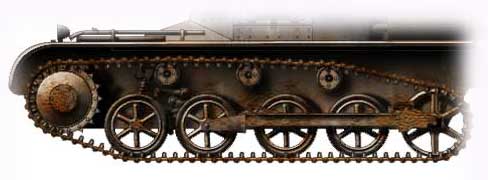 |
|
Panzerkampfwagen
I Ausf.A & Ausf.B suspension |
7.92
mm MG 13 & 34 Penetration of a shielding plate (mm) under a plunging angle of 30° |
|||||||
Ammo |
Weight |
Velocity |
100
m |
500 m |
1000
m |
1500 m |
2000
m |
| Patr Smk | 0.0115 kg |
785 m/s |
8 |
3 |
- |
- |
- |
Les pots d'échappements étaient disposés à l'arrière sur les deux garde-boue, protégés par un tôle perforée. L'accès au char se faisait via une trappe à deux battants sur le côtés gauche du compartiment de combat. L'éclairage comprenait un gros phare central monté sur le glacis. Sur les garde-boue étaient également disposés divers équipements comme un cric, une manivelle, un extincteur, une pelle, une hache, un pied de biche long (et un court), des cisailles et un bloc pour soutenir le cric. On trouvait également un câble de remorquage et un dispositif pour la marche en black-out. La suspension du Panzer I était à l'origine composé de quatre galets à bandage de caoutchouc oscillant sur des ressorts à lames. Trois rouleaux porteurs soutenaient une chenille mono-patin à guidage latéral. Les poulies de tension (à l'arrière et en contact avec le sol) étaient couplées de manière à s'articuler sur une fusée à rotule. Sur les modèles de série, un longeron arrière recouvrant les deux galets de suspension arrière sera installé. Les extrémités de ce longeron étaient reliés à l'axe des seconds galets de suspension et à la poulie arrière de tension par des barres d'accouplement à fourche portant des ressorts elliptiques dont les extrémités reposaient sur les axes des troisièmes et quatrièmes galets de suspension. Le mouvement de ces galets était contrôlé par des ressorts hélicoïdaux. Cette suspension était satisfaisante dans les basses vitesses mais transmettait un mouvement de tangage à haute vitesse à cause de la poulie de tension en contact avec le sol. Cependant il gardait une grande souplesse d'emploi. La suspension sur l'Ausf.B sera modifiée par l'addition d'un cinquième galet et un quatrième rouleau porteur. La poulie de tension fut soulevée pour ne plus être en contact avec le sol, ce qui améliora sensiblement la conduite de l'engin. Le nombre de patins par chenille était à l'origine de 84 unités, il passera à 100.
The mufflers were mounted on the back on the two mudguards, protected by a perforated sheet. The access to the tank was done via a hatch with two leaves on the left sides of the compartment of combat. Lighting included a large central headlight assembled on the glacis. On the mudguards was also laid out various equipment like jack, crank, extinguisher, shovel, axe, long foot of hind (and a court), shears and a block to support the jack. One also found a cable of towing and a device for walk in blackout. The suspension of Panzer I was in the beginning made up of four rollers with oscillating rubber binding on leaf springs. Three return rollers supported a mono-shoe track with side guidance. The pulleys of tension (at the back and in contact with the ground) were coupled so as to articulate itself on a spindle with kneecap. On the models of series, a back member covering the two rear road wheels will be installed. The ends of this member were connected to the axis of the second road wheels of suspension and to the back pulley of tension by tie-rods with fork carrying of the elliptic springs whose ends rested on the axes of the third and fourth road wheels. The movement of these road wheels was controled by helical springs. This suspension was satisfactory in low speeds but transmitted a movement of pitching to high speed because of the pulley of tension was in contact with the ground. However it kept a great flexibility. The suspension on Ausf.B will be modified by the addition of a fifth road wheel and a fourth return roller. The pulley of tension was raised not to be more in contact with the ground, which appreciably improved control of the machine. The number of links per track was at the origin of 84 units, it will pass to 100.
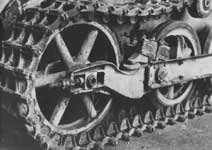 |
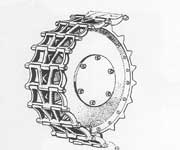 |
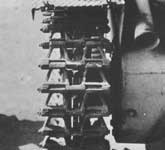 |
Panzer I Ausf.A idler |
Panzer I Ausf.A sprocket-wheel |
Panzer I Ausf.A tracks |
src: Panzer I - Horst Scheibert, Schiffer Military
History
|
||
Le moteur était un 4 cylindres Krupp M305 (essence) de 3.5 l de cylindrée, développant 57 cv à 2500 tours, doté d'un gros refroidisseur d'huile. Il était relié par un arbre à une boîte de vitesses à pignons coulissants dotée de cinq rapports (plus une marche arrière). Via un boîtier de commande, la puissance arrivait au mécanisme de direction (embrayage à frein) sur chacun des cotés et ensuite grâce à un réducteur aux deux barbotins placés à l'avant. Notons que plusieurs engins de pré-production furent équipés du moteur diesel Krupp M601 développant 45 cv à 2200 tours qui ne sera pas retenu pour la production en série. Plus tard le moteur original sera remplacé par un Maybach NL 38R de 100 cv à 3000 tours beaucoup plus fiable. Ces deux moteurs étaient tous les deux refroidis par eau. Le compartiment moteur du être élargi pour accueillir le nouveau moteur et le châssis allongé. Ces modifications assureront une conduite plus stable et une vitesse de pointe plus élevée: 37-40 km/h. Une nouvelle boîte de vitesse avec une meilleure démultiplication sera également installée, ce qui nécessita la modification de la partie avant du char pour accueillir l'engrenage de démultiplication.
The engine was one 4 cylinders Krupp M305 (gasoline) of 3.5 L of cubic capacity, developing 57 hp to 2500 turns, equipped with a large oil cooler. It was connected by a tree to a gear box with sliding pinions equipped with five speeds (more one reverse gear). Via a command box, the power arrived at the steering mechanism (brake clutch) on each side and then thanks to a reducer at the two sprocket-wheels placed at the front. Let us note that several machines of pre-production were equipped with the diesel engine Krupp M601 developing 45 hp to 2200 turns which will not be retained for the series production. Later the original engine will be replaced by Maybach NL 38R of 100 hp to 3000 turns much more reliable. These two engines were both cooled by water. The engine compartment of the being widened to accomodate the new engine and the chassis lengthened. These modifications will ensure a more stable control and a dash speed higher: 37-40 km/h. A new gear box with a better reduction will be also installed, which required the modification of the front part to accomodate the gears of reduction.
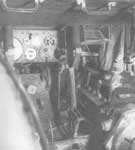 |
Driver station |
src: German light panzers 1932-1942 (Osprey
Military) - New Vanguard N°26
|
Sources:
- Connaissance de l'Histoire (Hachette) - HS n°3 - Blindés des origines à 1940
- Connaissance de l'Histoire (Hachette) - N°17 - " Les chars de combat allemands 39-45"
- Connaissance de l'Histoire (Hachette) - N°5 - " Véhicules blindés allemands 39-45"
- Les Blindés de la Seconde Guerre Mondiale (Atlas)
- German light panzers 1932-1942 (Osprey Military) - New Vanguard N°26
- Panzer I - Horst Scheibert, Schiffer Military History
- Site "Achtung Panzer" - http://www.achtungpanzer.com
- Site "WWII Vehicles" - http://www.wwiivehicles.com/germany/tanks-light/pzkpfw-i.asp
- Site "Second World War Armour" - http://www.onwar.com/tanks/index.htm
